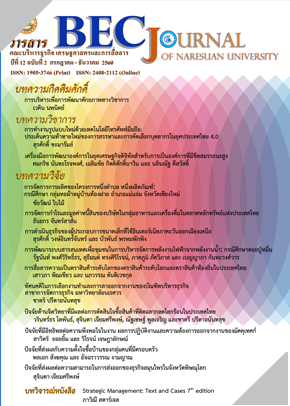Production Management of One Tambon One Product: A Case Study of a Weaving Group in Tong Fai Village, Mae Chaem District, Chiang Mai
Main Article Content
Abstract
The main objective of this research is to study production management of a weaving group in Tong Fai Village, Mae Chaem District, Chiang Mai. Hand woven cloth is one of the most well-known OTOP products in Chiang Mai, and the art of traditional weaving is valuable local wisdom that is worthwhile to be conserved. However, nowadays business environment is changing rapidly affecting most entrepreneurs including a weaving group in Tong Fai Village to adjust their business operations in line with the changing environment. Based on the in-depth interview with the community leaders as well as local entrepreneurs, the results show that the focal problems related to production management are to adjust some products making them more modernized and to adjust the product layout to be more efficient. The two main findings are in agreement with previous research. However, one issue differs from other prior studies in that advanced Industrial weaving machines cannot perfectly replace local wisdom. The analysis of production layout of a best selling product, namely, natural dye handbags with traditional methods of weaving called Jok pattern shows that the weaving group should adjust the production layout using largest time rule since this technique is the most efficient approach.
Article Details
References
2. Bertalanffy, L. V. (1950). An outline of general system theory. British Journal for the Philosophy of Science, 1(2), 134-165.
3. Boondao, R. (2016). Management information systems in the digital era. Nonthaburi: Lucky Book.
4. Chancharoen, P. and Chanvichai, K. (2016). An integrated marketing communications strategies for marketing promotion in international education agencies in Chiang Mai province. Journal of Business, Economics and Communications, 11(Special), 73-86.
5. Chiarakul, T. (2014). The problems and the adaptation of OTOP to AEC. Executive Journal, 34, 177-191.
6. Chokbandansuk, W., Anuloke, K. and Thongprayoon, W. (2016). Local wisdom inheritance of Teen Chok Tai-Yuan fabric production in Ratchaburi Province. Journal of the Association of Researchers, 21(1), 166-180.
7. Cresswell, J. W. (2013). Research design: qualitative, quantitative and mixed methods approaches (2nd ed.). Thousand Oaks, CA: Sage Publication.
8. Drucker, P. (1993). Management: tasks, responsibilities, practices. New York: Harper and Row.
9. Heizer, J., Render, B. and Munson, C. (2016). Operations management. Boston: Pearson.
10. Helms, M. M. and Nixon, J. (2010). Exploring SWOT analysis-where are we now?: A review of academic research from the last decade. Journal of Strategy and Management, 3(3), 215-251.
11. Jittimongkhon, S. and Jittimongkon, S. (2016). Foundations of economics. Bangkok: Mac Education.
12. Jundaeng, K. (2006). Production and operations management. Bangkok: Witty Group.
13. Kabbour, P. (2015). Marketing principle. Chiang Mai: Faculty of Management Sciences, Chiangmai Rajabhat University.
14. Kachornkittiya, N., Esor, U., Juntharattana, R., Wutthiwong, V. and Narkrueng, D. (2016). Corporate sustainability under the sufficiency economy of One Tambon One Product enterprise in the three southern border provinces. Journal of Business, Economics and Communications, 11(1), 98-112.
15. Khwanngern, S. (2006). Production and operations management. Bangkok: SE-ED.
16. Kotler, P. (2000). Marketing management: analyzing consumer marketing and buyer behavior (The Millennium). New Jersey: Prentice Hall.
17. Laosiritaworn, W. (2009). Operations management. Chiang Mai: S.T. Film and Plate.
18. Malasitt, S. (2005). Production and operations management. Bangkok: Samrada.
19. Nathalang, E., Eawsriwong, N., Panich, W., Tosittakul, R. and Chompoonuch, N. (2003). Local wisdom and knowledge management. Bangkok: Amarin.
20. Parasuraman, A., Zeithaml, V. A. and Berry, L. L. (1988). SERVQUAL: A multiple-item scale for measuring consumer perceptions of service quality. Journal of Retailing, 64(1), 12-40.
21. Ploymeka, C. (1980). Production management. Bangkok: SE-ED.
22. Santiwong, T. (2002). Management. Bangkok: Chulalongkorn University Press.
23. Sarungkarasiri, C. (2002). Production control and planning. Bangkok: Technology Promotion Association (Thailand-Japan).
24. Serirat, S., Hirankiti, S., Suwannapirom, S., Sriwarom, R. and Prapawanon, C. (2002). Organization and Management. Bangkok: Pattanasuksa.
25. Serirat, S., Raksitanon, P., Serirat, S. and Patawanich, O. (1998). Marketng strategies, marketing management, and case studies. Bangkok: Teera Film and Sitex.
26. Sirikrai, S. (2016). Operations Management in the business world. Bangkok: SE-ED.
27. Somrit, S. and Intakan, P. (2012). Manageming cost and return for Thai-Lue textile products in Chiang Kham, Phayao. Modern Management Journal, 5(1), 116-125.
28. Srisuwan, T. (1996). Management in the 21st Century. Bangkok: Main Manage.
29. The Central Information Systems, Ministry of Interior. (2016). Total revenue of OTOP in Fiscal year 2016 (From October 2015 to September 2016). Retrieved September, 14 2016, from http://203.114.112.233/CDDCENTER/cdd_report/otop_r04.php?&year=2559&org_group=0
30. Thianthai, C. (2004). Management: executive viewpoint. Bangkok: Top.
31. Tiangkate, N., Jakthip, W. and Intaphan, B. (2007). Weaving class: the inheritance knowledge of Mae Cham’s weaving. Chiang Mai: Ko-Kayan.
32. Vargo, S. L. and Lusch, R. F. (2004). Evolving to a new dominant logic for marketing. Journal of Marketing, 68(1), 1-17.
33. Watcharanulak, A. (2009). An application of lean system to garment manufaturing: polo shirt production line. Master Thesis, M.Eng, Rajamangala University of Technology, Pathumthani.

